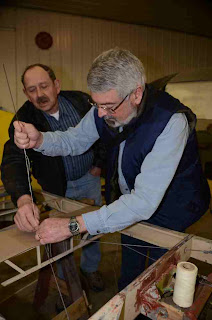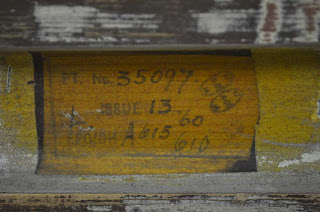Luke Penner, Harv's Air, was instructing spouses in the RAA-SFC sponsored Learn to Land course while his girlfriend, Natalie, helped mask the wood so we could prime the metal rib-cap fittings. Tough Coat metal primer from Goulet was used on the fittings.
Right to Left - Natalie, Jeannie Podaima (who just finished her first hour of flight training in the Learn to Land course) masking the wing.
Bob Stewart pitched in to help mask the wing while his wife, Darlene, learned how to land in the Learn to Land course.
Typically it takes us 1 1/2 DAYS to mask a wing; with everyone helping we were done in about 2 hours and had a lot of fun swapping stories from (right to left) Cayman Islands (Jeannie), New Caledonia (Natalie), the Arctic (Rick) and Cruising (Bob). Thank you for all your help!!!
This last wing will receive several coats of varnish over the weekend and then covering will begin after Tom and Steve Phinney complete the pre-cover inspection for the upper wings. The lower wings and ailerons are ready for cover. Let jill_oakes@umanitoba.ca know if you'd like to help with the covering or rib stitching or painting. Thank you to Jim Goold for lending his wing rotisserie. We're looking for someone willing to volunteer their paint spray booth when we get ready to paint. The first few coats of 'dope' will be brushed on...then we'll need a spray booth and someone with experience spraying.
Sunday, April 29, 2012
Cleaning all Four Tiger Moth Wings' Fittings
Out at Tom & Joyce's private airstrip, "Cooks Creek Intenational", Tom Stoyka carefully sand blasted all the external steel fittings - at least 5 layers of paint were peeled off! Rick Riewe stripped layers of paint off the inspection covers.
Fourth Tiger Moth Wing - preparing for varnish
George Inman removing fittings while cutting off the fabric and Vic Prefontaine removing the leading edge slats from the upper right wing. This wing had only one cracked nose rib, all components are in excellent condition, the trailing edge was wavy; possibly due to distortion from the fabric .
Bob Russell (Springfield Flying Club), Al Tring (Canadian Aviation Historical Society) and Jill Oakes straightening the trailing edge using Vic Prefontaine's jig. A strand of upholstery thread was tacked from one end of the wing to the other and tightened so it could be used as a straight reference point. Rick Riewe took the lead in removing the 4 layers of paint with Al & Jill helping. Ribs were re-glued with T88 glue from Bill LeBrun.
Friday, April 20, 2012
Covering the Wings and Ailerons with Fabric - supplies needed
Thank you to Rick Riewe for donating the Ceconite fabric and to Goulet Aircraft Supply for providing the materials with a discount.
If you or someone you know has any of the following they'd like to donate to the Brandon CATP Museum's Tiger Moth - please contact jill_oakes@umanitoba.ca or drop it off at the RAA hangar at Lyncrest Airport:
Fabric tape, rib stitching needles (we just need 2 more, we have two from Gil and Jill), rib stitching thread (we have some from Gil and Jill), wing rotisserie, volunteer rib stitchers (training provided!), more 400 grade sand paper, a paint booth to paint the wings and another volunteer with experience painting, and a donor interested in paying to get the flying wires zinc coated - too long to get them cadmium coated.
Work Party - Today - Friday
And ALL DAY Sunday - come for an hour or stay for the day and swap some great 1938 flying stories!
If you or someone you know has any of the following they'd like to donate to the Brandon CATP Museum's Tiger Moth - please contact jill_oakes@umanitoba.ca or drop it off at the RAA hangar at Lyncrest Airport:
Fabric tape, rib stitching needles (we just need 2 more, we have two from Gil and Jill), rib stitching thread (we have some from Gil and Jill), wing rotisserie, volunteer rib stitchers (training provided!), more 400 grade sand paper, a paint booth to paint the wings and another volunteer with experience painting, and a donor interested in paying to get the flying wires zinc coated - too long to get them cadmium coated.
Work Party - Today - Friday
And ALL DAY Sunday - come for an hour or stay for the day and swap some great 1938 flying stories!
Paulette brings homemade muffins + banana bread for the volunteer crew!
Paulette, retired Air Canada Stewardess, is welcomed to the Tiger Moth Restoration Team. She helped remove the fabric from the upper left wing on Thursday. With George Inman, Paulette, Rick and Jill working together we were able to remove the fabric and strip off 3 layers of paint on one side of the wing. We'll flip the wing and do the other side today. The trailing edge needs re-alignment and re-gluing. Tom and Steve Phinney will be back shortly to prepare a repair list once we have all the paint removed so they can inspect the wood.
Removing the fabric wrap on the wing tip bow.Paulette donated 3 cans of Tough Coat, Penetrating Oil, #400 sanding paper, and more scrapers - plus a fresh loaf of home-made banana brad and muffins.
Preparing Upper Wing for Fabric- George, Al, Peter, Paulette and more Help

Al Tring, a member of the CAHS and retired from Standard Aero is a regular member of the Tiger Moth Restoration Team - he meticulously cleaned all the metal fittings and leading edge.
Al Tring, Jill Oakes, and Rick Riewe masked off the metal pieces and prepared to paint them with green metal primer "Tough Coat" from Goulet Aircraft Supply.
Maurice April and Rick Riewe removed the masking material after a night of Zumba Dance-Exercising.
George Inman prepared the new rib caps from Sitka Spruce donated by Jim Goold, Gil Bourrier, and Bill LeBrun. George donated some more of that awesome sanding paper!
Peter Moodie had an hour to spare so dropped in to help - he cleaned the aileron control cables that had been soaking in varsol. They looked like new after he worked on them. We then soaked them in LPS1 overnight and wiped them with a dry cloth.
George Inman painted the drag and anti-drag wires on all 3 wings with "Tough Coat" green metal primer.
Once the paint was dry, George tied on the wire separators with waxed thread and a knot he uses in electrical wiring - it is really tight and impossible to unravel.
Upper Right Tiger Moth Wing
Joyce Stoyka and Rick Riewe removed the fabric from the upper right Tiger Moth wing a couple of weeks ago.
The serial numbers and identification plates had been covered with masking tape and then painted over top with white paint by previous restorers. The masking tape was carefully removed, the three layers of paint stripped off using a mild stripper "1850" leaving the identification plates in place - Thank you Rick, Al and George! Then the wing was repaired with sitka spruce + T88 glue, and varnished with 2-part epoxy varnish from Goulet Aircraft Supply. Tom & Joyce Stoyka have volunteered to gently sand blast the external fittings and coat them with Tough Coat next week. Thank you Tom and Joyce! Doug Render invented a system for removing paint from curved sections...a spoon ground down to the perfect radius ...thanks to the Lyncrest Flight Centre Community Club for donating the spoons!
George Inman removing three layers of paint from metal fittings.
Gil Bourrier noticed the leading edge dropped about 1/8" along the first 3 feet by the root rib.
Vic Prefontaine used a technique to jig the warped trailing edge back into it's original straight position that he had first used 60 years ago when he was working on the 20' long aileron of a DC3! We stretched a piece of upholstery thread along the edge and clamped the aircraft to upright posts - aligning the trailing edge to the thread.
 |
| Rick, Jim Goold, and John Blackner double checking the alignment of the leading and trailing edges. The same jig system used for the trailing edge was also used for the leading edge re-align. |
Tuesday, April 10, 2012
Rib stitching with Henry Riege - Covering Ailerons April 14th
Henry Riege from Oak Hammock Air Park led a rib stitching workshop at the RAA building with about 15 participants. He used the lower right Tiger Moth wing for demonstration and a piece of cardboard substituted for the fabric so we could more easily see the stitching system. Bob Stewart, Gil Bourrier, John, George Inman, and Henry Riege (lft-rht). April 14th we plan on covering the ailerons, drop by if you'd like to help.
Holes for stitches are pre-punched and aligned so thread between the ribs is vertical.Tightening the knot.
Ben Toenders practising for when we cover the Tiger Moth wings.
Peter Moodie practising the traditional stitch - the following series shows each of the steps.
H
Lower Left Wing - Pitot Tubing, Prep for Varnish, Visitors
Ted Hector, AME, checking over the ailerons - Gilbert Bourrier re-aligned the trailing edge and all joints were reglued
Vic Prefontaine (we're working on adding accents - still a mystery on this program!) bending the pitot tubing. The tubing was re-routed straight down the front edge of the front spar to the root spar rather than crossing over mid-wing.Root end of lower right leading edge spar.
Inter-wing strut mount area on leading edge spar of lower right wing.
Gil Bourrier is refurbishing the aileron sprocket and chain, which will be re-inserted in this aileron control box before covering with fabric.
Alan Tring, Rick Riewe, Paul Dyck and Jill removed excess paint from spars, glued with T88 reinforcement blocks on the wingwalk, re-glued rib ends in aileron well by removing screws, applying glue, countersinking holes and reinserting same screws into glue-filled holes. Gil Bourrier double checked the leading and trailing edges for alignment.
Lower right wing front spar serial number.
Alan Tring, CAHS Member, is aiming to fly in 100 different types of airplanes; including this Tiger Moth. Brandon CATP Museum looks forward to making Alan's dream come true and Harvey McKinnon has already taken him flying in the Museum's Harvard! Here Alan is helping mask off the metal pieces = preping for applying the zinc chromate provided by Goulet Aircraft Supplies.
Tom and Joyce Stoyka dropped in to see the project after being in Florida for about 4 months.
Alan Tring and Rick Riewe masking the lower right wing.
Bill Tweed, Michael Gillespie, and Dale Trueman (lft-rht) studying the serial number on the lower right aileron.
Rick Riewe spent several 12-hour days doing the finishing touches on preping the lower right wing for zinc chromate (metal) and varnish (wood).
Bill Tweed, Rick Riewe, Michael Gillespie and Dale Trueman - great stories of building warbird models were inspired by the rib jigs Gil Bourrier made for the Brandon CATP Museum. Ribs will be sold in the museum gift shop to raise funds for museum projects.
V
Subscribe to:
Posts (Atom)




















































